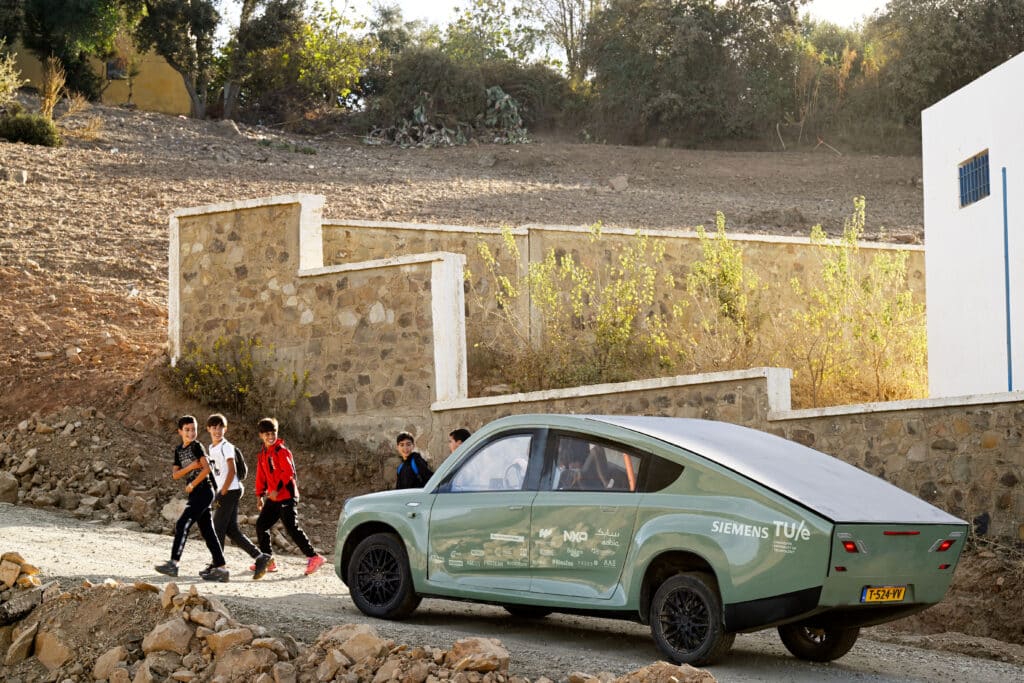Off-Road Solar SUV Drives Across Morocco Powered Only by the Sun’s Rays
Zero-emission cars are increasingly becoming the vehicle of choice among environmentally-conscious consumers. However, owning an electric vehicle can be daunting in areas with scarce charging infrastructure. This is where Stella Terra, a khaki-green Solar SUV, distinguishes itself. Equipped with solar panels on its sloping roof, the vehicle harnesses the sun’s energy to charge its electric battery, enabling it to cover great distances powered solely by solar energy. This innovation can potentially reshape the future of electric vehicles, making them a viable and convenient option regardless of the local charging infrastructure.

Built by a team of diligent students in the Netherlands at Eindhoven University of Technology (TUE), Stella Terra is hailed as “the world’s first off-road solar-powered vehicle.” It is an invention that promises to transform the automotive industry and connectivity in remote areas. In locales with less developed roads and less reliable energy grids, the Stella Terra Solar SUV can be an invaluable asset, ensuring mobility and energy efficiency regardless of the environment. Furthermore, its potential extends to emergency aid and deliveries, where its solar-powered capabilities could ensure essential services always reach their destination.
Prototype solar SUV tested in Morocco
After the prototype SUV was unveiled in September, the team embarked on a journey to Morocco to test Stella Terra on diverse off-road terrains. The expedition started in the bustling city of Tangier, proceeding through the rugged landscape of the Rif mountain range, which posed as Stella Terra’s inaugural off-road challenge, with its steep ascents and swift descents. Continuing southwards through the heritage city of Fes, the vehicle was tested on the mountainous trails of Midelt, a town renowned for being among Morocco’s highest. The journey culminated in the Sahara Desert’s vast expanses, where Stella Terra was put to the ultimate test on its loose sandy tracks. The variety of terrains served as the perfect real-world test bed for the solar-powered SUV, providing invaluable insights into its performance and resilience.
The vehicle covered an impressive distance of over 621 miles from the country’s northern coast down to the vast expanse of the Sahara Desert in the south. The arduous test drive across various terrains was a testament to Stella Terra’s adaptability and endurance, underscoring its unparalleled capability as a solar-powered off-road vehicle.

The road-legal Stella Terra boasts a top speed of 90 miles per hour. On a sunny day, its energy-efficient design allows it to cover a distance of approximately 441 miles on roads and roughly 342 miles off-road, the range is subject to the surface type. In less favorable weather with cloudy conditions, the team estimates the vehicle’s range could be reduced by approximately 31 miles. Impressively, the vehicle proved to be one-third more efficient than initially anticipated during the expedition, a testament to its meticulously engineered design. Its lightweight design proved advantageous on challenging terrains, reducing the likelihood of the vehicle getting stuck and exerting less pressure on its suspension system, enhancing its durability and performance.
“Stella Terra must withstand the harsh conditions of off-roading while remaining efficient and light enough to be powered by the sun. That is why we had to design almost everything for Stella Terra ourselves, from the suspension to the inverters for the solar panels,” said Wisse Bos, team manager of Solar Team Eindhoven. According to Bos, Stella Terra is five to ten years ahead of the current market. “We are pushing the boundaries of technology. With Stella Terra, we want to demonstrate that the transition to a sustainable future offers reasons for optimism and encourages individuals and companies to accelerate the energy transition.”

Stella Terra is 25% lighter than the average mid-sized SUV
Electric SUVs are generally heavier than standard electric vehicles due to the requirement for larger, heavier batteries to power them. This is why the team, consisting of 22 students, prioritized minimizing Stella Terra’s weight, with their design efforts focused on making every component highly efficient. The vehicle weighs at 2,645 pounds, approximately 25% lighter than the average mid-sized SUV. This impressive feat was achieved by incorporating an aerodynamic design that effectively reduces drag and using lightweight yet robust composite materials to cut weight. The result is a vehicle that operates efficiently and performs optimally across varying terrains, clearly embodying the team’s vision of an effective solar-powered off-road vehicle.
A solar campervan was previously developed at the university
Building on the concept of a solar-powered campervan previously developed at the university, Stella Terra has been designed with long-haul, multi-day journeys in mind. The team has cleverly incorporated elements of livability into the SUV, demonstrated, for instance, in the car seats, which fully recline to transform into a bed.
When stationary, the vehicle’s solar panels can be extended to optimize charging, serving a dual purpose as they also function as an awning providing shade. The team has also made significant strides in the design of highly efficient solar panel converters. This innovation benefits Stella Terra and holds promise for the broader solar industry, potentially heralding a new era of efficiency in solar energy conversion.
TUE team crowdfunds to help earthquake victims
The expedition was unaffected by the massive earthquake that hit Morocco in early September. However, deeply affected by the extensive damage the disaster caused across the country, the Stella Terra team felt compelled to take action. In response, they seized the opportunity to leverage their growing visibility, announcing a partnership with The Red Cross. Launching a crowdfunding campaign, they supported earthquake relief efforts. This display of solidarity exemplified a commitment to social responsibility, extending their mission beyond renewable energy and sustainable transportation.
TUE team announced in 2022 that Lightyear was beginning production of a solar EV
TUE’s automotive innovation lab has a rich history of pushing the envelope in solar-powered vehicle technology, spanning over a decade of research and development. However, the practical hurdle of transforming a concept car into a mass-market product has remained a significant challenge. In a noteworthy move, alums from the inaugural TUE Solar program team established a company, Lightyear, in 2022, aiming to manufacture a car outfitted with solar panels. Despite initial excitement, the company faced a setback when it had to file for bankruptcy earlier this year. In a testament to their resilience, however, Lightyear bounced back, relaunching months later with a renewed focus on a more affordable model. This bold pivot demonstrates the ongoing commitment to making solar cars a viable and accessible reality, continuing to expand the boundaries of renewable energy in transportation.

Electric Vehicle Marketing Consultant, Writer and Editor. Publisher EVinfo.net.
Services